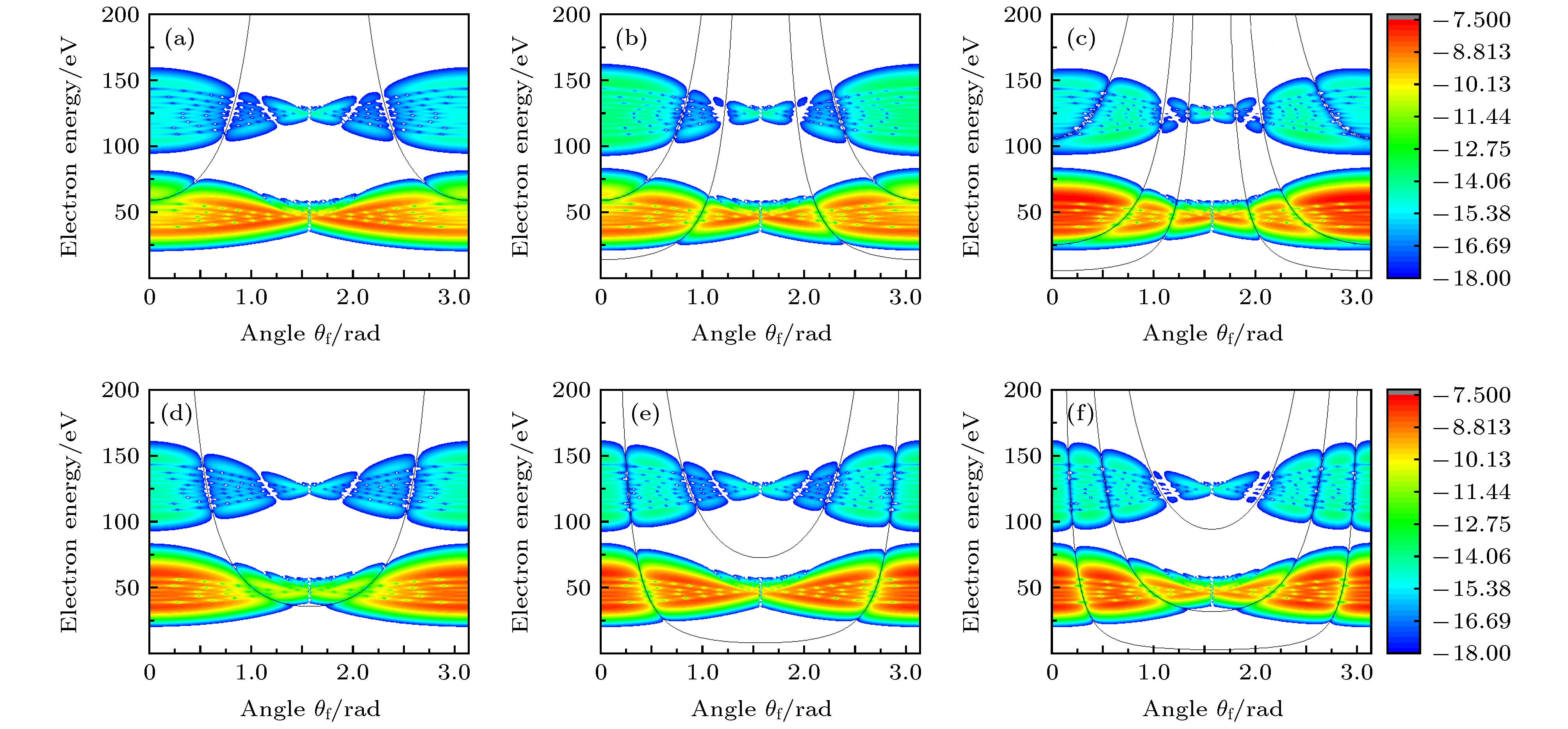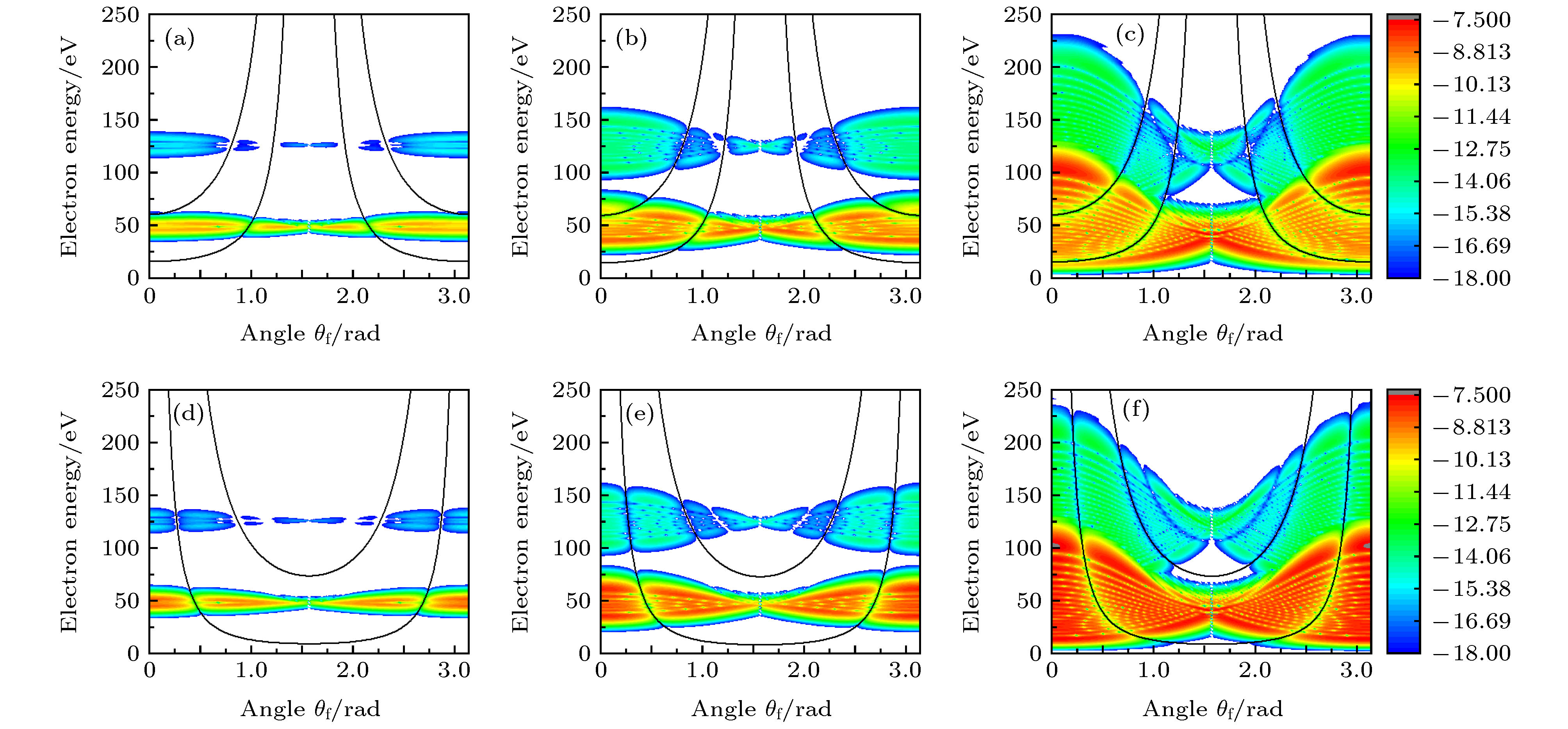-
Since imaging the geometrical structure of molecules can help to understand the microscopic world intuitively, and thereby to promote the development of physics, chemistry, material science and biological science, it has long been an important subject for scientists to probe the molecular internal structure. Generally, however, because of the relative complexity of the molecular internal structure, it is difficult to obtain the relevant information by ordinary experimental means. With the development of laser technology, especially the advent of intense ultrafast laser field, ultrafast laser pulse provides an unprecedented detection tool to investigate the related ultrafast dynamics. In recent years, strong field high-order nonlinear ultrafast processes, such as above-threshold ionization(ATI), high-order above-threshold ionization(HATI), high harmonic generation(HHG), and non-sequential double ionization (NSDI), were produced by using femtosecond ultrafast laser to excite molecules. Since the molecules excited in these processes emit the photon and electron signals pertinent to their internal structures, it is natural that one can obtain the imaging of molecular structure by extracting the signals. Recently, we have demonstrated that the structural information of SF6 molecules can be obtained by the interference fringes on the ATI spectrum using the infrared and ultraviolet bichromatic laser fields[arXiv, 1912.08499 (2019)]. In this paper, we use frequency-domian method, which is based on non-perturbed quantum electrodynamics, to investigate the direct above-threshold ionization (ATI) process of triatomic molecular ion
$ \rm H_3^{2+} $ with two different geometrical structures by monochromatic and bichromatic laser fields, and given the detailed analysis of the spectra for each case. Compared with the monochromatic laser field, it is found that the ATI spectrum by the bichromatic laser field is more sensitive to the geometrical configuration of molecular ion, thereby it can be applied to identify the different geometrical structure of molecules. In the case of bichromatic laser fields, the direct ATI spectrum show different interference fringes with different molecular configurations. We give the beginning and cutoff curves of each platform by employing the saddle-point approximation. Furthermore, we derive the destructive curves formulas for different molecular configurations in angle-resolved direct ATI energy spectra and momentum spectra, respectively, which carries the information about themolecular structure. In addition, it is found that the shape of the spectra can be modified by changing the molecular internuclear distance or varying the laser intensity. Thereby, it can be inferred that the ATI spectrum induced by bichromatic laser field has the ability to identify different configurations of the same molecules, which is instructive to image geometrical structure of complex molecules.-
Keywords:
- $ \rm H_3^{2+} $ molecular ion /
- direct above threshold ionization (ATI) /
- different molecular configurations
[1] Agostini P, Fabre F, Mainfray G, Petite G, RahmanN K 1979 Phys. Rev. Lett. 42 1127
 Google Scholar
Google Scholar
[2] Becker W, Liu X, Ho P J, Eberly J H 2012 Rev. Mod.Phys. 84 1011
 Google Scholar
Google Scholar
[3] SchaferK J, Yang B, DiMauro L F, Kulander K C 1993 Phys. Rev. Lett. 70 1599
 Google Scholar
Google Scholar
[4] Paulus G G, Nicklich W, Xu H, Lambropoulos P, Walther H 1994 Phys. Rev. Lett. 72 2851
 Google Scholar
Google Scholar
[5] Walker B, Sheehy B, Kulander K C, DiMauro L F 1996 Phys. Rev. Lett. 77 5031
 Google Scholar
Google Scholar
[6] Okunishi M, et al. 2008 Phys. Rev. Lett 100 143001
 Google Scholar
Google Scholar
[7] Li X F, LHuillier A, Ferry M, Lompre L A, Mainfray G 1989 Phys. Rev. A. 39 5751
 Google Scholar
Google Scholar
[8] LHuillier A, Lompre L A, Mainfray G, Manus C 1992 Adv. At. Mol. Opt. Phys. Suppl. 1 139
[9] Walker B, Sheehy B, DiMauro L F, Agostini P, SchaferK J, Kulander K C 1994 Phys. Rev. Lett. 73 1227
 Google Scholar
Google Scholar
[10] Becker A, Faisal F H 1999 Phys. Rev. A. 59 R1742
 Google Scholar
Google Scholar
[11] Meckel M, Comtois D, Zeidler D, et al. 2008 Science 320 5882
[12] Huismans Y, Rouzee A, Gijsbertsen A, et al. 2011 Science 331 6013
[13] Lötstedt E, Midorikawa K 2014 J. Phys. B. 47 204018
 Google Scholar
Google Scholar
[14] Yuan K, Lu H, Bandrauk A D 2017 J. Phys. B. 50 124004
 Google Scholar
Google Scholar
[15] Zhou X, Shi S, Li F, Guo Y, Yang Y, Meng Q, Chen J, Liu X and Wang B 2019 arXiv, 1912.08499
[16] Guo D S, Aberg T 1988 J. Phys. A: Math. Gen. 21 4577
 Google Scholar
Google Scholar
[17] Guo D S, Aberg T, and Crasemann B 1989 Phys. Rev. A. 40 4997
 Google Scholar
Google Scholar
[18] Gao L, Li X, Fu P, Freeman R R, Guo D S 2000 Phys. Rev A. 61 063407
 Google Scholar
Google Scholar
[19] Wang B, Gao L, Li X, Guo D S, Fu P 2007 Phys. Rev A. 75 063419
 Google Scholar
Google Scholar
[20] Kang H, et al. 2010 Phys. Rev. Lett 104 203001
 Google Scholar
Google Scholar
[21] Wang B , Guo Y, Chen J, Yan Z C, Fu P 2012 Phys. Rev. A 85 023402
 Google Scholar
Google Scholar
[22] Fu P, Wang B, Li X, Gao L 2001 Phys. Rev. A. 64 063401
 Google Scholar
Google Scholar
[23] Becker W, Grasbon F, Kopold R, Milosevic D B, Paulus G G, Walther H 2002 Adv. Atom. Mol. Opt. Phys. 48 35
 Google Scholar
Google Scholar
[24] Shi S, Jin F, Wang B 2019 Chin. Phys. B 28 023202
 Google Scholar
Google Scholar
[25] Guo D-S, G W F Drake 1992 J. Phys. A: Math. Gen. 25 5377
 Google Scholar
Google Scholar
[26] Zhang K, Chen J, Hao X L, Fu P, Yan Z C, Wang B 2013 Phys. Rev. A. 88 043435
 Google Scholar
Google Scholar
-
图 3 在双色线性偏振激光场下两种不同几何构型的H32+分子角分辨直接ATI能谱 (a)线形; (b)三角形. 核间距为r0 = 2.0 a.u.,
${t_{c{q_2}}} = {\omega _1}{t_0} ({q_2} = 1, 2)$ Figure 3. Angle-resolved direct ATI spectra of H32+molecular ions at internuclear distance r0 = 2.0 a.u. by bichromatic linearly polarized laser fields: (a) Linear; (b) triangular. Here,
${t_{c{q_2}}} = {\omega _1}{t_0} ({q_2} = 1, 2)$ .图 5 在双色线性偏振激光场下两种几何构型的
$ \rm H_3^{2+} $ 分子不同的核间距条件下角分辨直接ATI能谱 (a)−(c)线形; (b)−(f)三角形. (a), (d)核间距为r0 = 1.0 a.u., (b), (e)核间距为r0 = 2.0 a.u., (c), (f)核间距为r0 = 3.0 a.u.Figure 5. Angle-resolved direct ATI spectra for linear (a)−(c) and triangular (b)−(f)
$ \rm H_3^{2+} $ molecular ions by bichromatic linearly polarized laser field with r0 = 1.0 a.u. (a), (d), r0 = 2.0 a.u. (b), (e), r0 = 3.0 a.u. (c), (f).图 6 在双色线性偏振激光场下两种几何构型的
$ \rm H_3^{2+} $ 分子不同激光强度条件下角分辨直接ATI能谱 (a)−(c)线形; (b)−(f)三角形. 核间距为r0 = 2.0 a.u., (a), (d)激光强度为${I_1} = {I_2} = 1.0 \times {10^{12}}$ W/cm2, (b), (e)${I_1} = {I_2} = 1.0 \times {10^{13}}$ W/cm2, (c), (f)${I_1} = {I_2} = 1.0 \times {10^{14}}$ W/cm2Figure 6. Angle-resolved direct ATI spectra for linear (a)−(c) and triangular (b)−(f)
$ \rm H_3^{2+} $ molecular ions with r0 = 2.0 a.u. by bichromatic linearly polarized laser fields. The intensity of laser fields are${I_1} = {I_2} = 1.0 \times {10^{12}}$ W/cm2 (a), (d),${I_1} = {I_2} = 1.0 \times {10^{13}}$ W/cm2 (b), (e),${I_1} = {I_2} = 1.0 \times {10^{14}}$ W/cm2 (c), (f), respectively. -
[1] Agostini P, Fabre F, Mainfray G, Petite G, RahmanN K 1979 Phys. Rev. Lett. 42 1127
 Google Scholar
Google Scholar
[2] Becker W, Liu X, Ho P J, Eberly J H 2012 Rev. Mod.Phys. 84 1011
 Google Scholar
Google Scholar
[3] SchaferK J, Yang B, DiMauro L F, Kulander K C 1993 Phys. Rev. Lett. 70 1599
 Google Scholar
Google Scholar
[4] Paulus G G, Nicklich W, Xu H, Lambropoulos P, Walther H 1994 Phys. Rev. Lett. 72 2851
 Google Scholar
Google Scholar
[5] Walker B, Sheehy B, Kulander K C, DiMauro L F 1996 Phys. Rev. Lett. 77 5031
 Google Scholar
Google Scholar
[6] Okunishi M, et al. 2008 Phys. Rev. Lett 100 143001
 Google Scholar
Google Scholar
[7] Li X F, LHuillier A, Ferry M, Lompre L A, Mainfray G 1989 Phys. Rev. A. 39 5751
 Google Scholar
Google Scholar
[8] LHuillier A, Lompre L A, Mainfray G, Manus C 1992 Adv. At. Mol. Opt. Phys. Suppl. 1 139
[9] Walker B, Sheehy B, DiMauro L F, Agostini P, SchaferK J, Kulander K C 1994 Phys. Rev. Lett. 73 1227
 Google Scholar
Google Scholar
[10] Becker A, Faisal F H 1999 Phys. Rev. A. 59 R1742
 Google Scholar
Google Scholar
[11] Meckel M, Comtois D, Zeidler D, et al. 2008 Science 320 5882
[12] Huismans Y, Rouzee A, Gijsbertsen A, et al. 2011 Science 331 6013
[13] Lötstedt E, Midorikawa K 2014 J. Phys. B. 47 204018
 Google Scholar
Google Scholar
[14] Yuan K, Lu H, Bandrauk A D 2017 J. Phys. B. 50 124004
 Google Scholar
Google Scholar
[15] Zhou X, Shi S, Li F, Guo Y, Yang Y, Meng Q, Chen J, Liu X and Wang B 2019 arXiv, 1912.08499
[16] Guo D S, Aberg T 1988 J. Phys. A: Math. Gen. 21 4577
 Google Scholar
Google Scholar
[17] Guo D S, Aberg T, and Crasemann B 1989 Phys. Rev. A. 40 4997
 Google Scholar
Google Scholar
[18] Gao L, Li X, Fu P, Freeman R R, Guo D S 2000 Phys. Rev A. 61 063407
 Google Scholar
Google Scholar
[19] Wang B, Gao L, Li X, Guo D S, Fu P 2007 Phys. Rev A. 75 063419
 Google Scholar
Google Scholar
[20] Kang H, et al. 2010 Phys. Rev. Lett 104 203001
 Google Scholar
Google Scholar
[21] Wang B , Guo Y, Chen J, Yan Z C, Fu P 2012 Phys. Rev. A 85 023402
 Google Scholar
Google Scholar
[22] Fu P, Wang B, Li X, Gao L 2001 Phys. Rev. A. 64 063401
 Google Scholar
Google Scholar
[23] Becker W, Grasbon F, Kopold R, Milosevic D B, Paulus G G, Walther H 2002 Adv. Atom. Mol. Opt. Phys. 48 35
 Google Scholar
Google Scholar
[24] Shi S, Jin F, Wang B 2019 Chin. Phys. B 28 023202
 Google Scholar
Google Scholar
[25] Guo D-S, G W F Drake 1992 J. Phys. A: Math. Gen. 25 5377
 Google Scholar
Google Scholar
[26] Zhang K, Chen J, Hao X L, Fu P, Yan Z C, Wang B 2013 Phys. Rev. A. 88 043435
 Google Scholar
Google Scholar
Catalog
Metrics
- Abstract views: 13069
- PDF Downloads: 68
- Cited By: 0



















 DownLoad:
DownLoad:



















